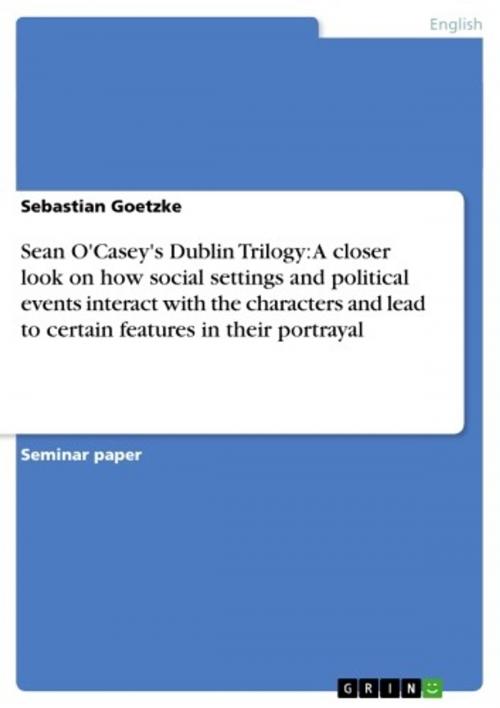Sean O'Casey's Dublin Trilogy: A closer look on how social settings and political events interact with the characters and lead to certain features in their portrayal
Fiction & Literature, Literary Theory & Criticism, British| Author: | Sebastian Goetzke | ISBN: | 9783638249416 |
| Publisher: | GRIN Verlag | Publication: | January 30, 2004 |
| Imprint: | GRIN Verlag | Language: | English |
| Author: | Sebastian Goetzke |
| ISBN: | 9783638249416 |
| Publisher: | GRIN Verlag |
| Publication: | January 30, 2004 |
| Imprint: | GRIN Verlag |
| Language: | English |
Seminar paper from the year 2001 in the subject English Language and Literature Studies - Literature, grade: 2,0 (B), University of Dusseldorf 'Heinrich Heine' (Anglistics Institute), course: Sean O'Casey - The Dublin Trilogy, 17 entries in the bibliography, language: English, abstract: Hundreds and thousands of articles and books have already been published on Sean O'Casey, his life and his writings. One may rightly ask whether it is necessary to compose yet another essay about the famous Irish writer. It is! While reading Sean O'Casey and once, if not Irish born, you have learned to read and accept his 'Irish-English' language and background, one can't argue that his writings are brilliant. They are rich in images, metaphors, language and intentions. It is almost impossible to get a comprehensive and finally decisive look upon his work. Especially the 'Trilogy' provides a lot to interpret and to discus from various points of view depending on the specific status quo of a society. This 'Hausarbeit' now is not meant to give yet another attempt to analyse the author's intentions from a new angle but to give an overview about what famous and less popular critics have said about O'Casey's 'Trilogy' so far. It's also neither a try to picture, as in a historical dictionary, the political events in a chronological order. These surroundings and the setting they provide for the Dublin Plays are of course crucial in order to understand O'Casey and therefore worth to be mentioned in the context of this essay. More important though are the questions 'WHY' and in a sense 'HOW' the author used the particular social and political actions and influences to create a certain setting for his characters; how they cope or fail with the intrusion of the outside world into their daily live and business. The 'Hausarbeit' is divided into three main parts. The first one deals with Sean O'Casey and his life as a playwright. The second one gives an insight look into 'Juno and the Paycock' with a special emphasis on the portrayed poverty and death and on how Juno and Boyle are presented. Eventually the third one provides a closer view on how O'Casey dealt with the 'Easter Rising' of 1916 in his work 'The Plough and the Stars'. It is shown what intentions, ideas and dramatic devices critics believe the author has chosen in order to create a certain result amongst his audience. It goes of course without saying that an advanced familiarity with the context of the presented texts must be required to understand the ideas mentioned in this 'Hausarbeit'.
Seminar paper from the year 2001 in the subject English Language and Literature Studies - Literature, grade: 2,0 (B), University of Dusseldorf 'Heinrich Heine' (Anglistics Institute), course: Sean O'Casey - The Dublin Trilogy, 17 entries in the bibliography, language: English, abstract: Hundreds and thousands of articles and books have already been published on Sean O'Casey, his life and his writings. One may rightly ask whether it is necessary to compose yet another essay about the famous Irish writer. It is! While reading Sean O'Casey and once, if not Irish born, you have learned to read and accept his 'Irish-English' language and background, one can't argue that his writings are brilliant. They are rich in images, metaphors, language and intentions. It is almost impossible to get a comprehensive and finally decisive look upon his work. Especially the 'Trilogy' provides a lot to interpret and to discus from various points of view depending on the specific status quo of a society. This 'Hausarbeit' now is not meant to give yet another attempt to analyse the author's intentions from a new angle but to give an overview about what famous and less popular critics have said about O'Casey's 'Trilogy' so far. It's also neither a try to picture, as in a historical dictionary, the political events in a chronological order. These surroundings and the setting they provide for the Dublin Plays are of course crucial in order to understand O'Casey and therefore worth to be mentioned in the context of this essay. More important though are the questions 'WHY' and in a sense 'HOW' the author used the particular social and political actions and influences to create a certain setting for his characters; how they cope or fail with the intrusion of the outside world into their daily live and business. The 'Hausarbeit' is divided into three main parts. The first one deals with Sean O'Casey and his life as a playwright. The second one gives an insight look into 'Juno and the Paycock' with a special emphasis on the portrayed poverty and death and on how Juno and Boyle are presented. Eventually the third one provides a closer view on how O'Casey dealt with the 'Easter Rising' of 1916 in his work 'The Plough and the Stars'. It is shown what intentions, ideas and dramatic devices critics believe the author has chosen in order to create a certain result amongst his audience. It goes of course without saying that an advanced familiarity with the context of the presented texts must be required to understand the ideas mentioned in this 'Hausarbeit'.















